Table of Contents
Just about everyone either knows someone who has had a stroke or has had a stroke themselves. Strokes cause neurological damage and can be very debilitating with disabling effects that can last for years.
Unfortunately, many people who have had a stroke in the past are at risk of developing another stroke in the future.
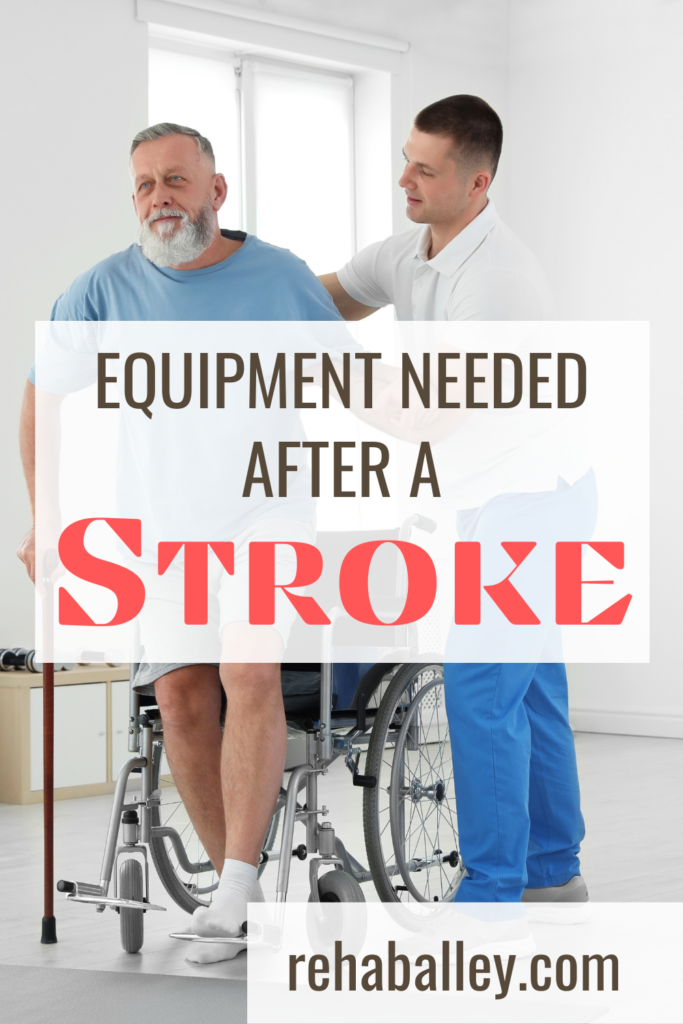
According to stroke statistics, every 40 seconds someone in the United States has a stroke. Furthermore, 1 in 4 people over the age of 25 years old will have a stroke in their lifetime. Stroke risk increases with age and doubles each decade after the age of 55.
Factors such as insurance can lead to fewer days spent in a rehabilitation center and faster discharges home from the hospital following a stroke.
For this reason, it is important to know how to care for yourself and/or a loved one at home.
There are several things to consider when returning home from the hospital. In this blog, I will discuss various durable medical equipment and assistive devices that can assist with the support and recovery of an individual after they’ve had a stroke.
Property of rehaballey.com
Most of the equipment that I will be discussing is the same equipment used in hospitals and rehabilitation centers, and can also be purchased online for additional use and assistance while at home.
So without further ado, let’s dive into the equipment that I recommend for individuals following a stroke.
Walking Aides
Rolling Walker (LINK)
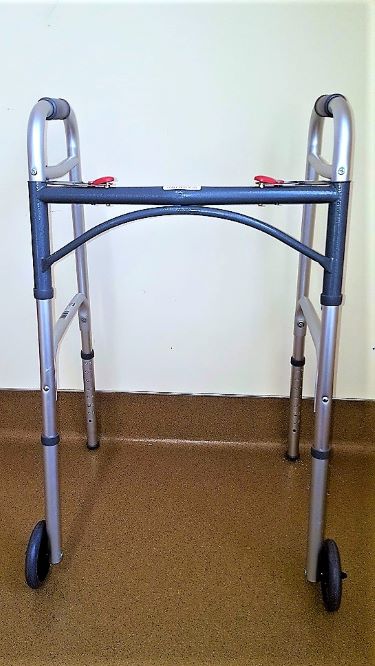
The most common and standard device used for walking is a rolling walker. A standard rolling walker has 2-wheels on the front and stationary legs on the back to promote a more fluid walking pattern.
Standard rolling walkers are slower than 4-wheeled walkers or rollators and therefore are recommended for individuals who have less balance and control.
Please refer to my blog titled “Where to Buy Walkers for Seniors: A Review of (2) Main Types of Light-Weight Walkers for the Elderly (LINK) for additional information on standard rolling walkers vs. 4-wheeled walkers.
Many different types of devices can attach to rolling walkers, that can be used to support the involved or hemiparetic (weaker) arm.
Property of rehaballey.com
The most common devices include: A rolling walker with a platform device, and/or a rolling walker with a hand splint device. I will discuss these (2) devices in the next paragraphs.
Rolling Walker with Platform (LINK)
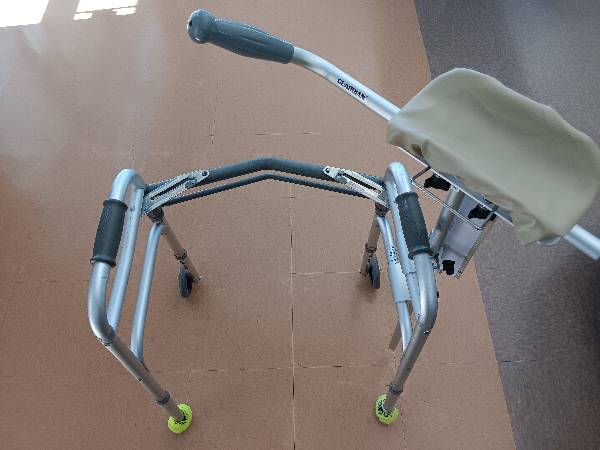
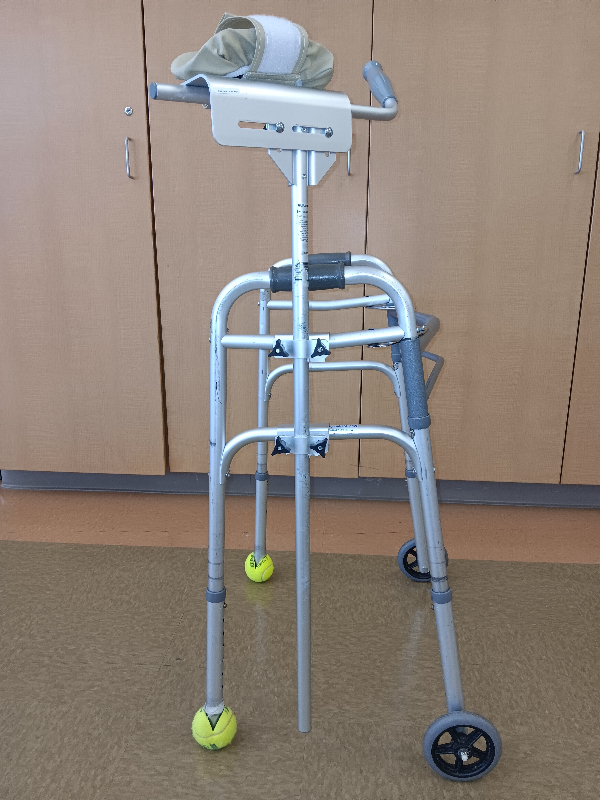
An upper extremity platform is a device that can be bought separately from a rolling walker and can attach to either side of a rolling walker.
The primary purpose of a platform is to support the hemiparetic or weaker arm while walking. A platform attachment is recommended for individuals who have very little movement or control of their arm following a stroke.
Property of rehaballey.com
It is important to keep the weaker arm supported in an upright position because muscles supporting the shoulder are not strong enough to support the bones, ligaments, and other structures of the shoulder joint.
Therefore, shoulder dislocations known as subluxations are very common if adequate support is not provided.
Rollator (LINK)
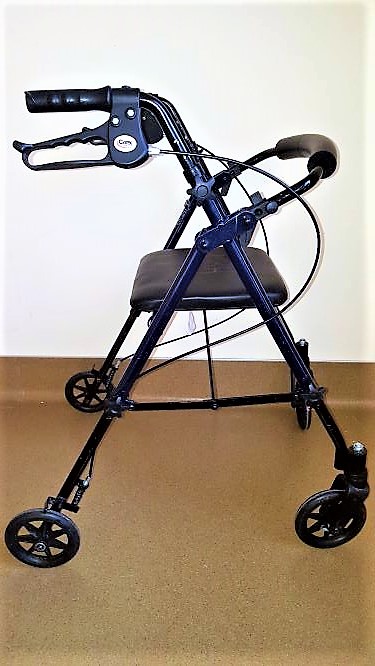
A rollator or 4-wheeled walker is a progression from the standard rolling walker. Rollators have 4 wheels (2 in the front and 2 in the back) that allow for more fluid walking motion and higher speeds.
Unlike the standard rolling walkers, rollators have a seat and a locking mechanism in the front for safety when sitting and standing.
Property of rehaballey.com
Rollators, however, are only recommended for individuals who have better balance and control when walking.
Rolling Walker with hand splint (LINK)
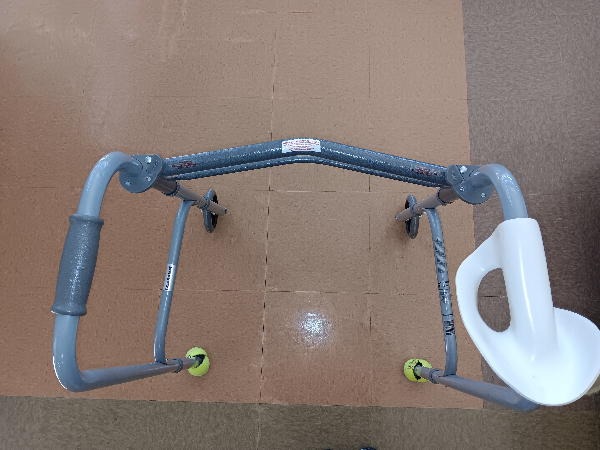
A hand splint is another device that can attach to a standard rolling walker that provides support to the hemiparetic (weaker) hand.
Some individuals after a stroke have adequate muscular support of their shoulder, but have decreased grip strength and therefore are unable to hold onto small devices.
A hand splint provides a wider grip allowing for the hand to be partially opened while walking with a walker.
Hemiwalker (LINK)
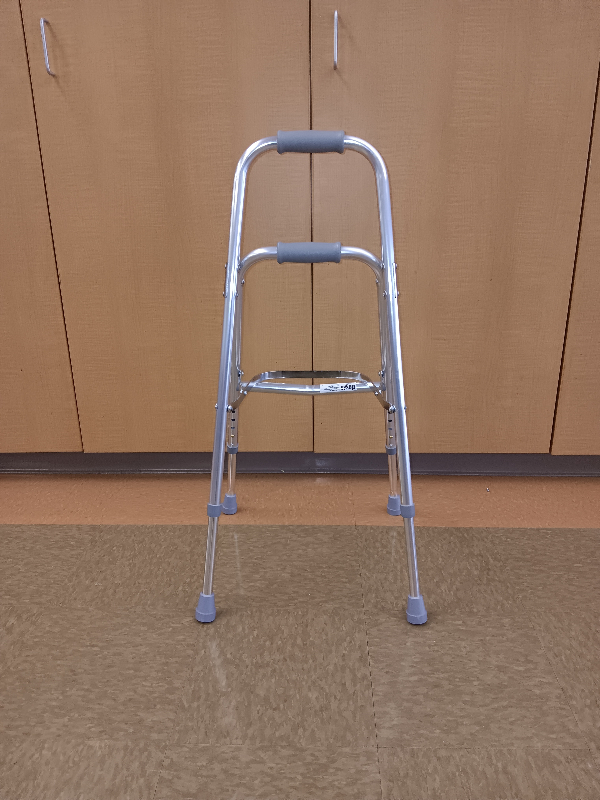
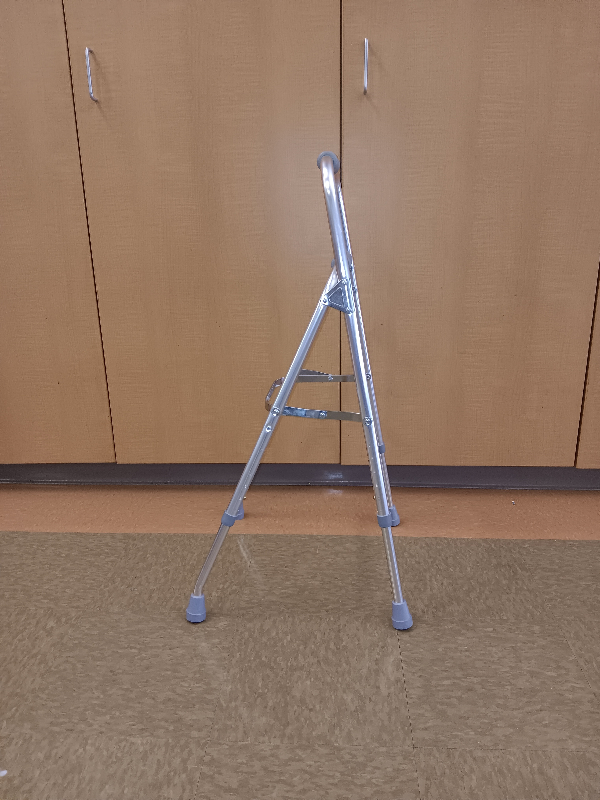
A Hemi walker is similar to a cane and is used to support the weaker side of the body when walking.
Hemiwalkers have 4 wide legs and offer more support than a cane. Hemiwalkers are used mostly in a rehabilitation setting to prepare individuals for walking with a cane.
Canes
Many different types of canes can assist with walking, each providing support based on the individual’s balance and fall risk.
A good rule of thumb to remember is that the more legs a cane has typically the greater the support an individual will have when walking. The most common types of canes include:
- Single-tip canes (LINK)– Provides the least amount of support
- Hurrycanes (LINK)– Usually consist of 3-4 connected tips spaced very closely together that provide greater support when walking as compared to the single-tip-cane.
- Quad Canes (LINK)– Comes with either 4 small legs (small-based quad cane), or 4 largely spaced apart legs (large-based quad cane) that typically provide the greatest amount of support when walking.
Many different types of accessories can be purchased with a walker or cane, and are recommended and beneficial to either have on hand or use while walking. These accessories include:
- Walker Basket (LINK)
- Walker Bag (LINK)
- Walker Caps (LINK) for easier gliding
- Cane Tips (LINK)
Bathroom Aides
Transfer-Tub Bench (LINK)
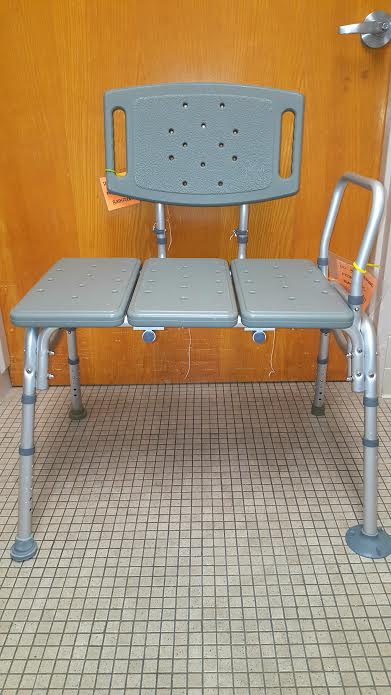
A Transfer-tub bench is designed to fit over a bathtub eliminating the need to step over the tub interface. Half of the transfer-tub bench fits inside the tub while the other half is positioned outside of the tub.
Property of rehaballey.com
For use, simply sit on the side of the bench that is positioned outside of the tub and scoot or slide over into the tub.
Shower Chair (LINK)
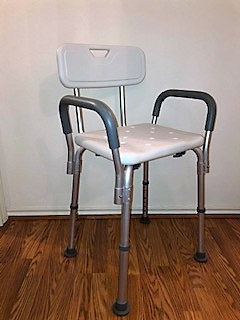
A shower chair is similar to a transfer-tub bench and can assist with bathing and showering without the need for prolonged standing. A shower chair, unlike the transfer-tub bench, is used inside a walk-in shower rather than a bathtub.
I recommend using a shower chair with armrests provided in the link above.
3-in-1 Commode (LINK)
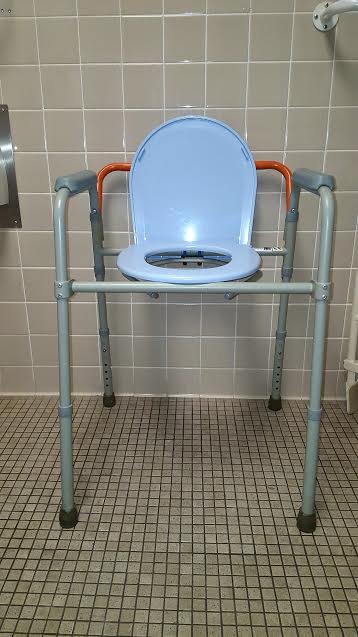
One of the most helpful bathroom aides for individuals following a stroke is A 3-in-1 commode chair. A 3-in-1 commode chair, as the name implies, is 1 device that has 3 different uses.
You can use it Near the bed for easier and quicker use which eliminates the need to travel to the bathroom, you can remove the bucket and use it over the toilet as an elevated toilet seat, or you can completely remove the seat and use the rails to push off of when sitting and standing from the toilet.
Grab bars (LINK)
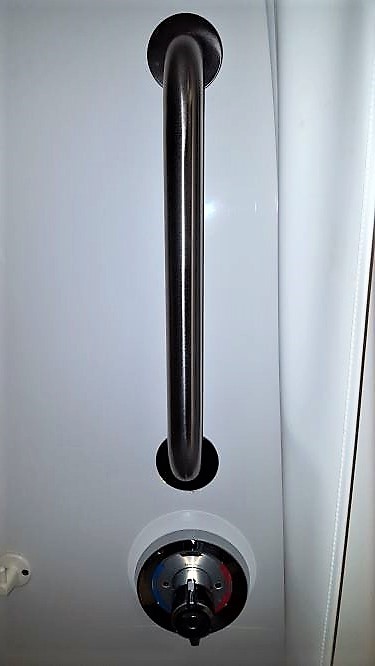
As a physical therapist, I strongly recommend the use of grab bars near the toilet, as well as inside the tub or shower for added security.
also recommend installing grab bars rather than using suction cup bars because it is sturdier and provide better support.
Property of rehaballey.com
There are ADA compliance measures to consider, however, when installing grab bars. Please refer to ada.gov (LINK) for information on how to properly install grab bars in the bathroom.
Long-handled Bath Sponge (LINK)
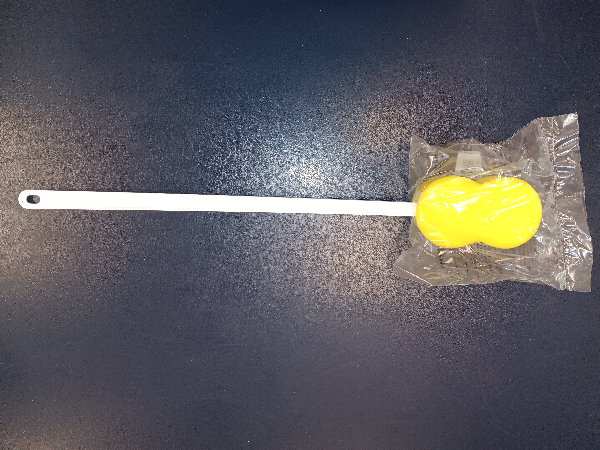
A long-handled bath sponge can be used to assist with hard-to-reach places while bathing.
It is recommended for individuals who have limited mobility in the arm and shoulder, as well as individuals who have blood pressure issues, vestibular issues, experience dizziness with position changes, or are on special precautions.
A long-handled bath sponge will limit the amount of bending, twisting, and turning to provide greater comfort and safety while bathing.
Raised Toilet Seat (LINK)
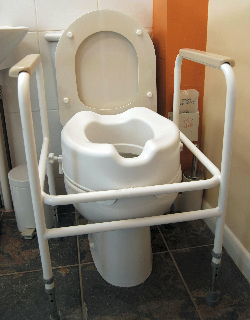
A raised toilet seat can be useful for individuals who have difficulty standing from lower surfaces.
For use, simply lift the toilet seat and secure the raised toilet seat over the toilet bowl. Like the shower chair, I recommend a raised toilet seat with armrests for support when sitting and standing.
Dressing Aides
Shoe horn (LINK)
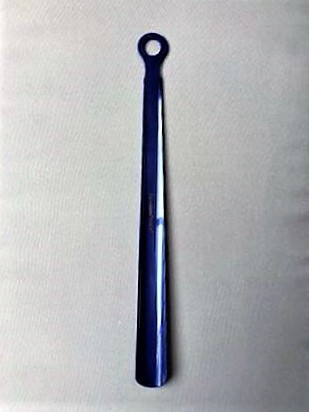
A shoe horn is used to hold the back of the shoe in place to make the shoe easier to slip on.
Due to the length of the shoe horn, this reduces the amount of bending over needed to put on the shoes. Shoe horns can either be plastic, metal, or stainless steel depending on personal preference.
Sock Aide (LINK)
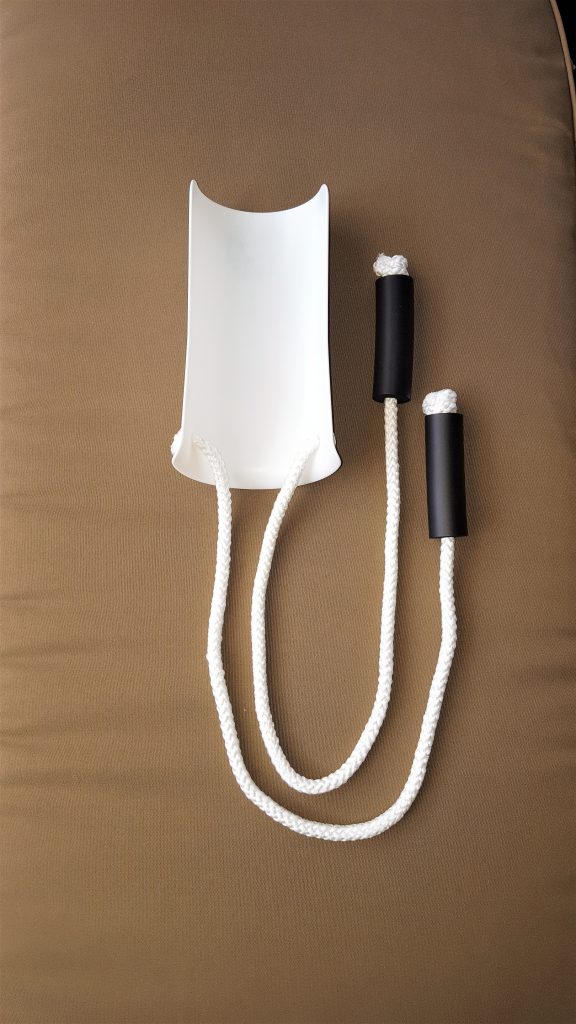
A sock aide can either be rigid or flexible and is used to assist with putting on socks. Like the shoe horn, sock aides also reduce the amount of bending over needed to put on socks.
Sock aides come with 2 long handles for use that allow the sock to slide easier on the foot.
Property of rehaballey.com
For use simply wrap the sock around the sock aide and use the handles to place the sock aide around your foot. Then use the handles to slide the sock aide up and out of the sock, while the sock remains on the foot.
Dressing Stick (LINK)
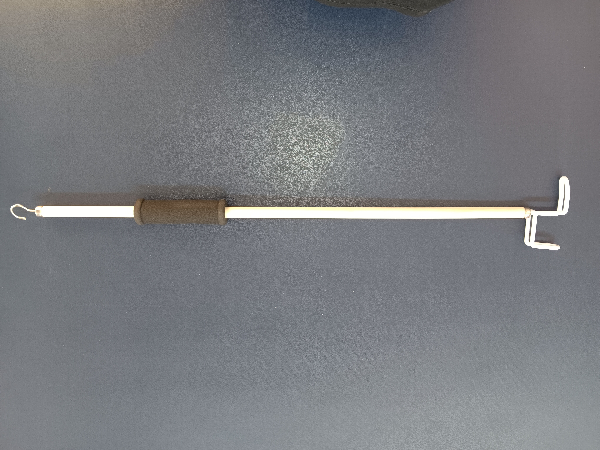
The dressing stick is a unique device and is primarily used to adjust clothing, footwear, and position clothing more comfortably before, during, and after the dressing task. Examples for use includes: removing socks and shoes, adjusting socks, and so forth.
Reacher (LINK)
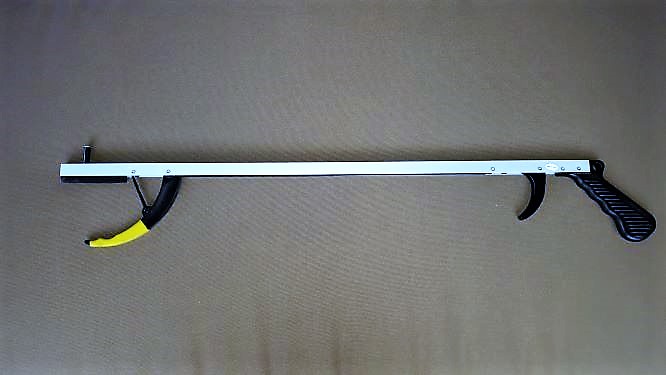
A reacher can either be short or long and is used to retrieve items that are on the floor or overhead in hard-to-reach places.
This device is useful because it eliminates the need for bending over to retrieve items off of the floor, and/or makes it easier to retrieve items on higher surfaces.
No Tie Shoes (LINK)
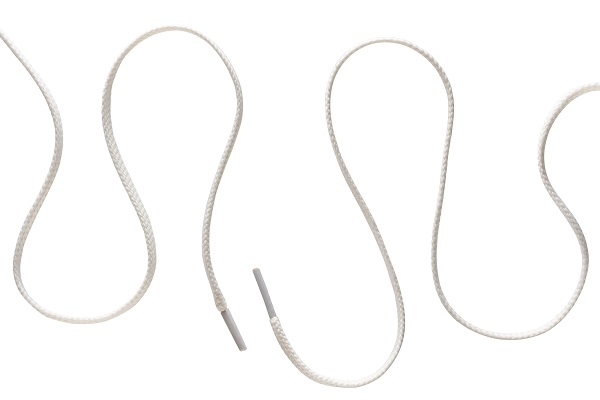
No-tie (elastic) shoe laces are designed to fit securely into the eyelets of a shoe and hold its form preventing the need to bend over to tie shoe laces.
No tie shoe laces work hand-in-hand with the shoe horn listed above.
Property of rehaballey.com
for alternative options, you can purchase a shoe that’s specifically designed to allow the foot to slide more easily in and out.
For this, I recommend Orthofeet (LINK), who not only designs hands-free shoes but designs shoes for over 20+ foot conditions including diabetes, neuropathy, bunions, plantar fasciitis, gout, knee pain, back pain, hip pain, and so forth.
Hip Kit (LINK)
For individuals who need all of the above items to assist with their dressing task, a hip kit will be the most cost-effective option.
Hip kits are an all-in-1 dressing kit and usually contain the following items:
- Sock Aide
- Shoe Horn
- Elastic Shoe Laces
- Dressing Stick
- Reacher
- Leg Lift (not mentioned above)
Alley Tips: Although hip kits are most popular for individuals following hip surgery, hip kits can be used for anyone needing assistance with dressing tasks including those who have had a stroke.
Ankle foot orthoses AFO (LINK)
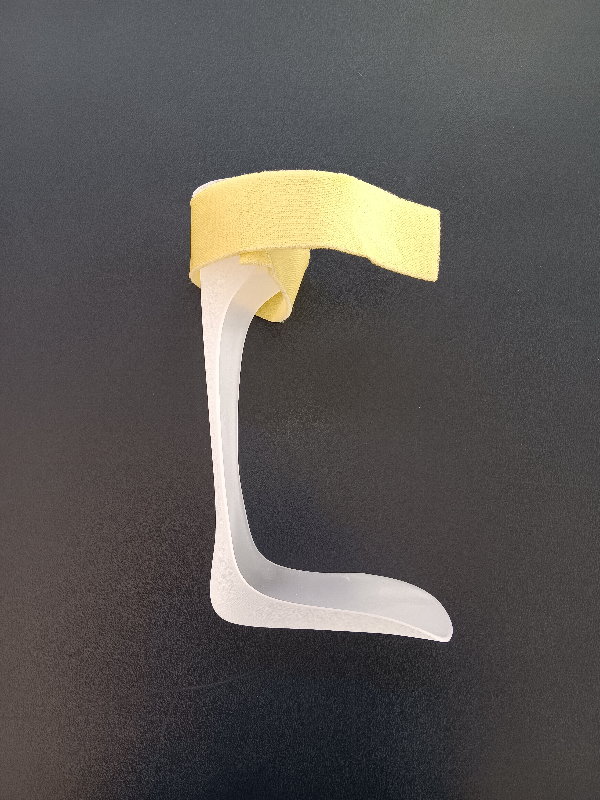
Lastly, an ankle foot orthosis or AFO is a type of ankle and foot support device used to prevent the foot from dragging the floor or ground when walking.
This device is recommended for individuals with drop foot following a stroke. AFOs are typically a rigid, plastic device that fits securely inside the shoe.
Property of rehaballey.com
The AFO keeps the foot in a neutral position reducing foot drag while walking.
Alley Tips: There are braces designed to hold the foot upright while walking as well, including the foot-up brace (LINK), which I recommend to provide more comfort and ease of use.
Upper Extremity Support
GiveMohr Sling (LINK)
an individual may experience weakness (hemiparesis) in one arm after a stroke. As discussed in the previous section, it is important to keep the hemiparetic weaker arm elevated due to the risk of shoulder subluxation or dislocation.
For this reason, a sling may be recommended when walking or standing.
The issue with a standard sling is that it places the shoulder in an inward position causing increased shoulder tightness.
Instead, I recommend using a GiveMohr sling. The GiveMohr sling supports the arm when standing or walking while keeping the shoulder aligned in a more neutral position which reduces the risk of shoulder contractures and tightness.
Wheelchair lap trays (LINK)
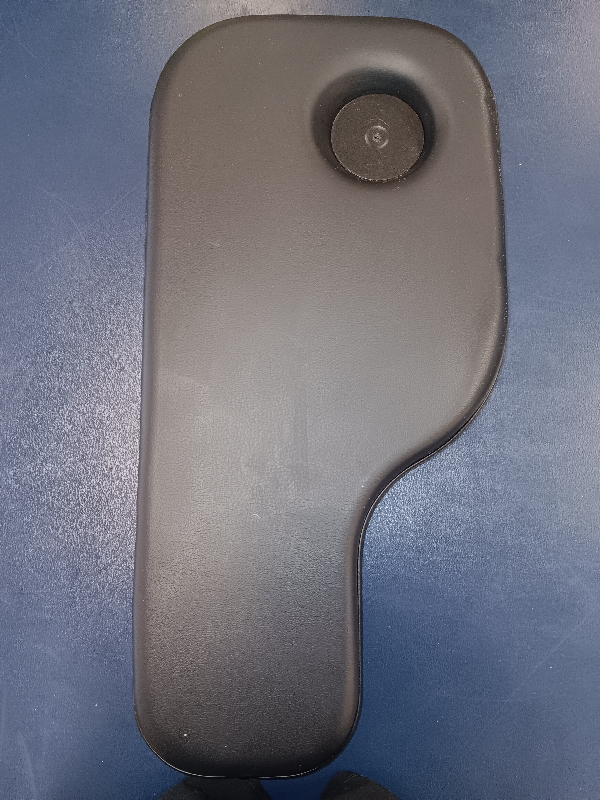
Wheelchair lap trays are an accessory that can be purchased when purchasing a wheelchair.
Wheelchair lap trays support the hemiparetic weaker arm while sitting in a wheelchair which reduces the risk of shoulder subluxations and dislocations.
Hand splints
Hand splints are typically custom-made and are fitted by a professional (usually the Occupational Therapist) in a hospital or other rehabilitation setting.
Property of rehaballey.com
Hand splints are used to position the hand to prevent tightness or contractures, which increases the ability to use the hand functionally following a stroke.
Hand splints and other splinting devices should be recommended and fitted by an orthotists or other healthcare professional.
Kinesio-Tapping (LINK)
Kinesio-tapping is a technique that is also used to prevent shoulder subluxations and dislocations.
Tapping offers a convenient way of supporting the shoulder because it does not involve any equipment other than the tape itself.
Tapping also allows for full, unrestricted use of the arm or extremity and provides a more affordable way of supporting the shoulder.
Property of rehaballey.com
Tapping, however, can only be applied by a healthcare professional and is not recommended for individuals who are at an increased risk for skin breakdown.
Wheelchairs & Accessories
Wheelchairs
Standard wheelchair (LINK)
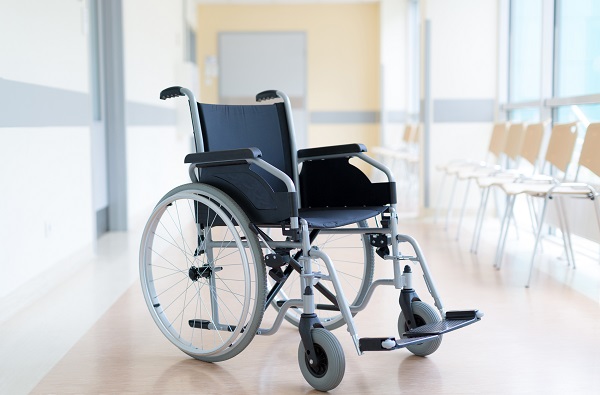
Standard wheelchairs typically come in 4 main sizes depending on hip width and body weight. The 4 main sizes includes: A 16” chair, used for smaller adults, teens, or older children, An 18” chair, which is the standard size for most adults, A 22” chair, and A 24” chair used for bariatric individuals.
Most wheelchairs can be ordered with multiple accessories including leg rests, foot rests, wheelchair cushions, and seat belts, most of which will be discussed in the next sections.
Transport wheelchair (LINK)
A transport wheelchair is only designed to transport an individual short distances from one place to another; for example from the parking lot to inside of a building.
A transport chair, however, is unable to be used independently by the individual as compared to the standard wheelchair. Therefore, an individual must rely on being transported with assistance from another person.
Reclining Wheelchair (LINK)
A reclining wheelchair is a type of standard wheelchair with a moveable backrest that can recline in various positions.
Property of rehaballey.com
The reclining wheelchair can be used for individuals with blood pressure issues who can not tolerate sitting upright for long, or individuals with neck pain and/or cervical spine issues.
The reclining chair can also be used for individuals with pressure ulcers or those who are at risk for skin breakdowns, however, there is another chair better used for this purpose that I will discuss in the next section.
Tilt-in-space wheelchair (LINK)
Lastly the tilt-in-space wheelchair allows for an individual’s entire body to be tilted backwards without changing the angle of their hips unlike the reclining wheelchair.
The tilt-in-space wheelchair is typically more comfortable for an individual since their body angle and position remains the same. The Tilt-in-space wheelchair can be used for individuals with the following issues:
- Fluctuating and unstable blood pressure
- Poor sitting upright balance
- Decreased tolerance sitting upright for long periods of time
- Skin breakdown or pressure ulcers
- Muscle contractures
- Neck pain or cervical spine issues
Power Chair, Scooter (LINK)
In more severe cases, an individual may need a power wheelchair or a scooter to mobilize safely due to severe functional limitations.
These limitations may include but are not limited to quadriparesis (weakness in both legs and both arms), severe contractures limiting the use of both arms, and individuals who are bedridden.
Property of rehaballey.com
Alley Tips: Power chairs and scooters are not recommended for individuals who are capable of mobilizing in a standard wheelchair.
Although the task may be difficult mobility is encouraged as much as possible to improve strength, range-of-motion, and neuromuscular function following a stroke.
Wheelchair Accessories
Leg rests vs. foot rests
In addition, certain accessories also come with the purchase of a wheelchair including either leg rests or foot rests.
The primary difference between a leg rests (LINK) and foot rests (LINK) are that foot rests are stationary and are designed to keep the feet off of the floor while mobilizing in a wheelchair, whereas leg rests are designed to elevate the entire leg in various positions.
Property of rehaballey.com
Leg rest are recommended and commonly used for individuals with
- edema or swelling
- increased leg pain
- lines and tubes such as wound vacs
- leg braces
- individuals that have fractures or special precautions that require the legs to be elevated.
Wheelchair cushions
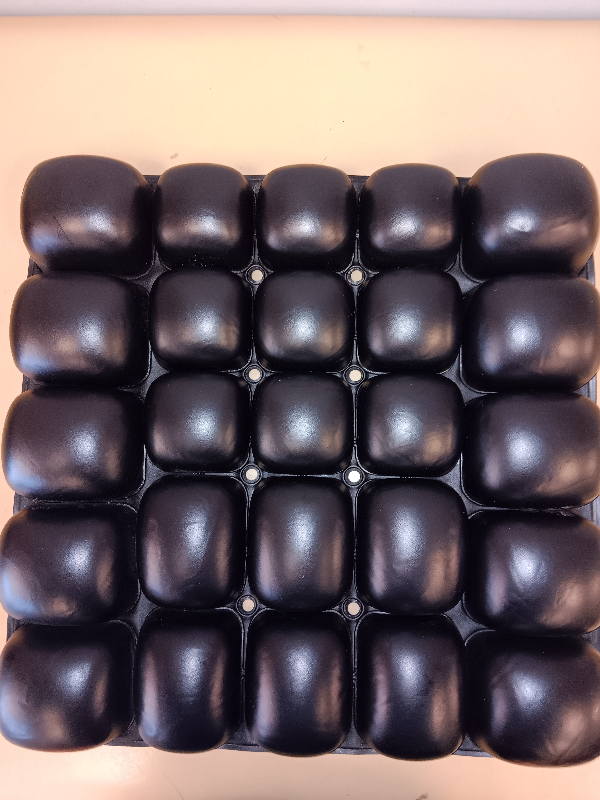
many different types of wheelchair cushions can also be purchased as an accessory when purchasing a wheelchair.
Three primary cushions that I typically recommend for individuals following a stroke are the standard foam cushion, gel-based cushion, and an air or roho cushion.
- Standard foam wheelchair cushions (LINK) are primarily used for general use and comfort when sitting in a wheelchair. These cushions come in various sizes, and tend to be the most affordable for patients.
- Gel-based cushions (LINK) add more support and can often contour to the body to redistribute weight preventing skin breakdown.
- air or roho cushions (LINK) add the most support and are used for individuals who are at severe risk for skin breakdown, and/or those who already have skin breakdown, pressure ulcers, or wounds.
Alley Tips: Make sure when purchasing any wheelchair accessories ie: Laptrays, cushions that the size of the accessory corresponds to the size of the wheelchair.
For example, when purchasing an 18” wheelchair, make sure to also purchase an 18” cushion, back rest, lap tray, and so forth.
Kitchen Aides (LINK)
There are many different types of kitchenware designed to adapt to the needs of individuals following a stroke. Some of these adaptations include:
- Wider, non-slip grips on spoons and forks designed for individuals with decreased grip strength
- Weighted utensils designed for individuals with ataxia and/or decreased motor control
- Curved utensils for individuals with decreased range-of-motion
- Specialty-shaped knives for easier chopping and cutting
- Large digit timers and thermometers for individuals with visual impairments.
- Feeders and arm supports for individuals who are unable to feed themselves due to arm weakness.
Transfer Assist Devices
Transfer board (LINK)
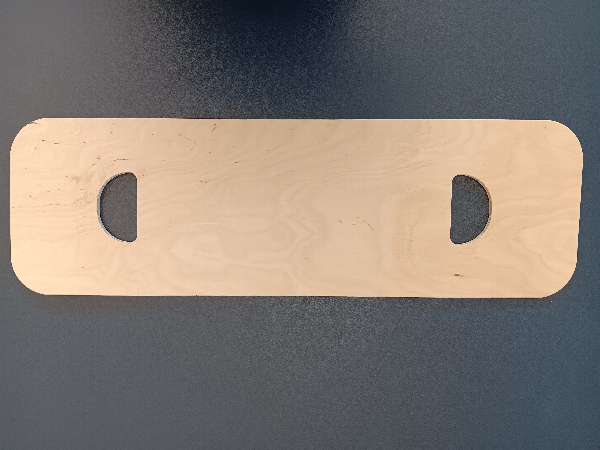
A transfer board can be used to transfer an individual from one surface to another while remaining in a seated position; for example from bed to the chair, or from the chair to the toilet.
A transfer board is used when an individual is either unable to stand or needs quite a bit of assistance to stand.
Property of rehaballey.com
To reduce the amount of stress or strain on an individual and the individual’s caregiver, simply place one end of the board under the thigh, and the other end towards the direction of the surface they will be transferring to. The individual will then slide their bottom on the board until they reach their destination.
Alley Tips: In order to effectively use the transfer board, each surface must be around the same height. Otherwise, it will be too difficult to slide onto a taller surface.
Make sure the individual’s feet are on the floor during the transfer. The individual must have good sitting balance to be able to transfer with the transfer board safely.
Patient lifts
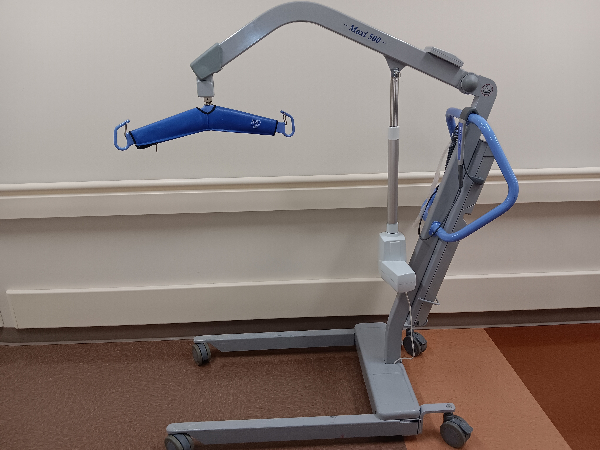
Patient lifts are mechanical transfer devices used for individuals who are unable to stand or require multiple people to transfer safely from one surface to another.
A patient lift is also recommended for bariatric individuals who are unable to stand, and/or individuals who are unable to use the slide board due to poor sitting balance.
Patient lifts typically come with a sling and a lift system designed to lift the individual from one surface to another while secured in a sling.
Property of rehaballey.com
The 2 main types of patient lifts are the hydraulic lifts (LINK) which require manual use of a lever in order to lift an individual from one surface to another, and the electric lift (LINK) which operates with the push of a button.
Alley Tips: Electric patient lifts are typically more expensive than the hydraulic lifts.
Make sure to check the maximal weight of a patient lift before purchasing.
Rehab Alley recommends training on the use of a patient lift before purchasing.
Stair lift (LINK)
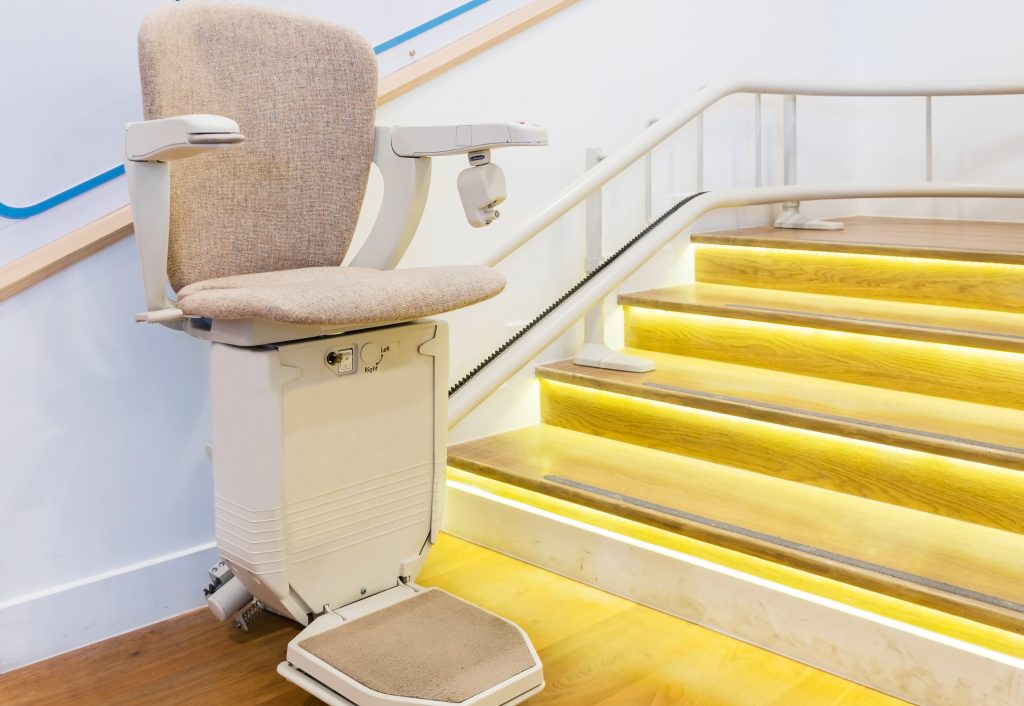
A stair lift is another mechanical device used to transfer an individual up and down the stairs. This device is recommended for individuals who are unable to safely climb stairs due to weakness, poor standing balance, and/or other factors.
A stair lift operates electrically and must be installed by a professional. There are companies such as Local Home Safety quotes (LINK), that will estimate the service needed and recommend companies for installation.
Wheelchair Ramps (LINK)
Wheelchair ramps are used for individuals who are unable to safely ascend or descend outdoor steps.
A wheelchair ramp can either be built permanently in place of steps, or can be purchased for temporary use over steps.
Property of rehaballey.com
Similar to the grab bars mentioned above, wheelchair ramps must comply with ADA standards for proper use. Please refer to ada.gov for further details.
Alley TIps: Rehab Alley recommends having rails installed on or near a wheelchair ramp for added security.
Stand Assist Device (LINK)
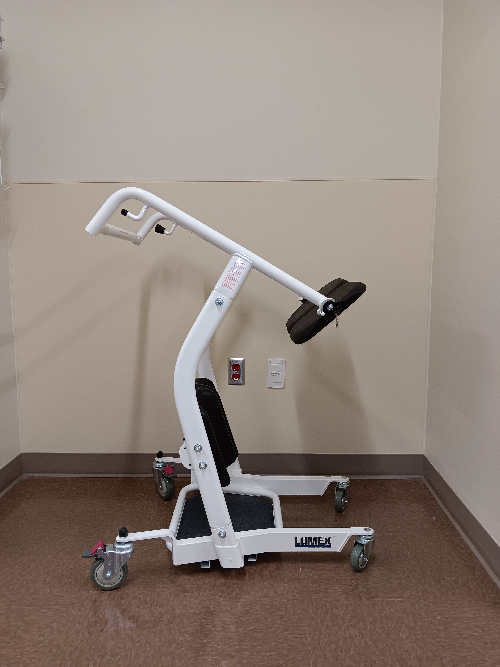
A stand assist device has been gaining quite a bit of attention lately, particularly in hospital settings.
A stand assist device is another transfer device used for individuals who can stand briefly but are unable to maintain standing for long.
A stand assist or lift assist is a rolling device that is operated manually and is equipped with 2 rigid wings that raise and lower.
Once an individual is seated in the device, they can then be wheeled from one location to another; for example from the bed to the bathroom.
Property of rehaballey.com
For use simply wheel the device in front of the individual, assist the individual to a standing position, lower the wings to allow the individual to sit onto the wings, then wheel the individual to their desired location.
Other Devices
Medical Alert Systems (LINK)
I highly recommend a medical alert system for elderly and senior citizens who live alone and who are at risk for falls and other medical emergencies.
Property of rehaballey.com
A medical alert device can be purchased as an in-home base unit, or a pendant to be worn around the neck for on-the-go, quick and easy access to a medical expert with just 1 click of a button.
Medical Alert Systems are integrated with wireless voice, data, and GPS technology. This enables real-time location tracking and monitoring services in case of an emergency either at home or away from home.
Medical Alert Systems can be used for emergencies such as falls, heart attacks, strokes, excessive uncontrolled bleeding, and other medical-related emergencies.
Podus boot (LINK)
A podus boot is an orthotic shoe that is designed to be worn while in bed.
The purpose of this shoe is to maintain the ankle joint at a 90-degree angle to reduce the development of foot drop contractures while sleeping.
This shoe can also be used to elevate the heel while in bed therefore reducing the chances of skin breakdown and pressure sores on the heels.
Car Assist Handle (LINK)
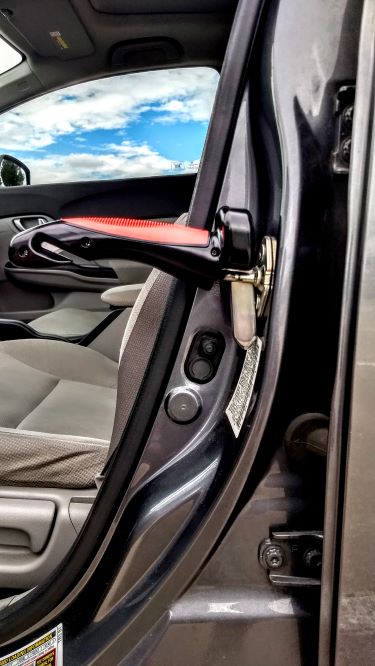
A car assist handle is a device that is used to assist individuals with sitting and standing from a vehicle by acting as an additional lever for support.
This handle is designed to fit in the door latch of a vehicle and does not require any additional installations or set-up.
Car door assist handles fit universally in just about any vehicle and are small, light-weight, and cost-effective.
Property of rehaballey.com
I recommend this device to individuals who have difficulty transferring in and out of their vehicles following a stroke.
Hospital beds (LINK)
Hospital beds may be needed for individuals who have difficulty breathing and/or swallowing and require the head of the bed to be elevated for feeding and other task.
Hospital beds are also recommended for individuals who are mostly bed-bound and/or who have difficulty transferring in and out of a standard bed due to significant weakness and balance issues.
Property of rehaballey.com
Hospital beds can either be semi-electric where only the head and foot of the bed elevates and lowers, or full-electric where the head, foot, and total height of the bed raises and lowers.
Alley Tips: I also recommend purchasing a bed with rails to further assist with rolling and transferring in and out of bed.
For additional products and devices, I recommend Health Products For You (LINK) which has a wide array of healthcare related products including mobility, ostomy, mastectomy, incontinence, and wound care supplies in addition to the mobility devices listed in this article.
Health Products For You (HPFY) also has separate stores specifically offering products for Women, and specifically for rehabilitation including durable medical equipment, exercise equipment, and various rehabilitation products.
Property of rehaballey.com
In addition, please check out my blog titled “What You Need to Know About A Stroke and Rehabiliation After a Stroke” (LINK) for general information regarding strokes and recovery.
Hopefully, this blog helps you on your road to recovery after you or your loved ones have had a stroke.
Feel free to use my contact page at rehaballey.com for questions or additional concerns/feedback. GOD BLESS YOUR ENDEAVORS!!

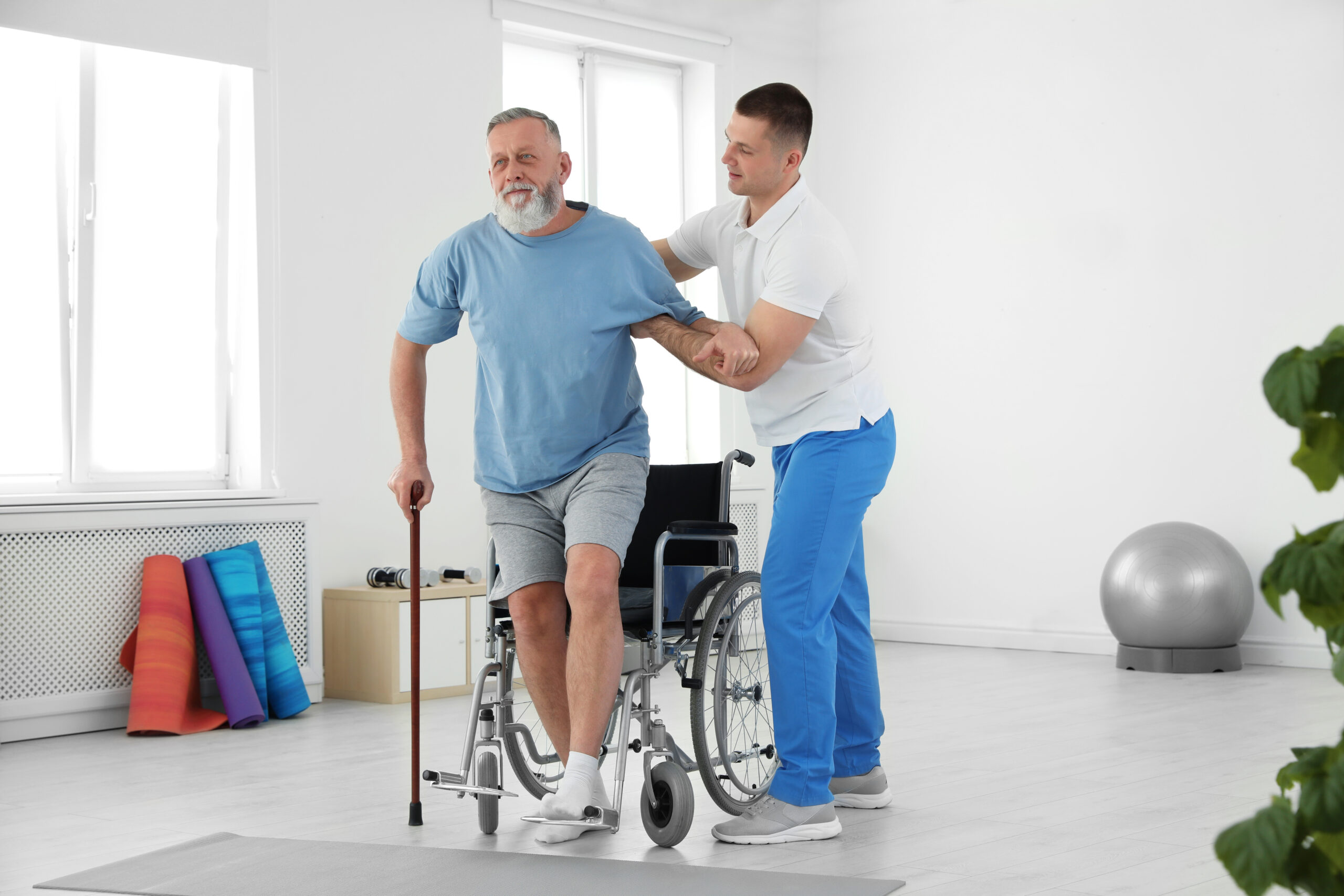

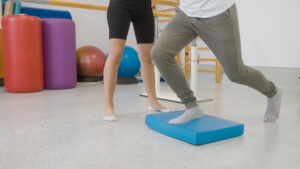
Wonderful blog!!
I especially enjoyed the knowledge of the writing and all the supporting links. It’s very refreshing to have a website that offers any age group the proper advice on the right equipment to use if and when in need. Most facilities will advise people of what to use without advising them the proper way of usage, which might lead to more injuries and longer healing time because the equipment was use incorrectly.
I appreciate Rehab Alley for all the hard work and knowledge that’s being provided to anyone in need.
Keep up the good work and may God continue to use the writer in such a positive and honest way.
I am so glad that you found this article informative and insightful. Rehab Alley strives to provide high-quality information to all individuals with an acute injury or illness. Strokes are becoming more and more prominent, and more than ever people need assistance caring for themselves and/or their loved ones after a stroke. Hopefully, this article will help to inform them on what they need to help them heal and improve their function.